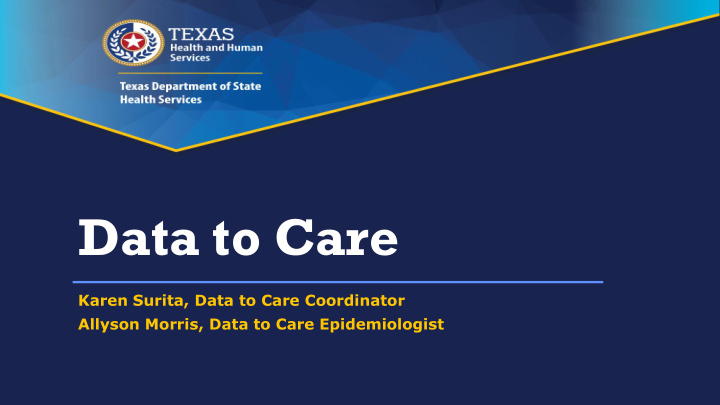



Data to Care Karen Surita, Data to Care Coordinator Allyson Morris, Data to Care Epidemiologist
Background A public health strategy which aims to identify people living with HIV (PLWH) who have been diagnosed but are not in care, and to engage or re-engage these individuals in medical care Addresses the first two goals of the National HIV/AIDS strategy: • Reduce the number of people who become infected with HIV • Increase access to care and optimize health outcomes for people living with HIV 6/26/2018 2
Goals • Increase the proportion of PLWH engaged in HIV medical care • Increase the proportion of PLWH linked to HIV medical care within 12 months of their HIV diagnosis • Increase the proportion of PLWH retained in HIV medical care • Prioritize re-linkage to care services 6/26/2018 3
Data to Care and the Cascade of Care Data to Care identifies PLWH who may be out of care and attempts to link them to care 6/26/2018 4
Evolution of Data to Care • Data to Care began under HIV Prevention: Category C 2012 2014 • HIV Prevention: Category C funding ended • Data to Care continued utilizing HIV Prevention and general revenue funds 2015 • Data to Care expanded to four project sites around Texas 2016 • Expand program by partnering with new providers 2019 6/26/2018 5
Methods
Data Sources • Electronic Lab Reporting Care • Ryan White • AIDS Drugs Assistance Program (ADAP) • Addresses on labs and prescriptions Locating • Accurint • Texas Department of Criminal Justice Vital • Texas Vital Statistics • National Death Index Status • Social Security Death Index 6/26/2018 7
What defines someone as out of care? A newly-diagnosed individual not • receiving care within 6 months of diagnosis A PLWH who has previously been in • care but has not received any type of care within the last 12 months
Types of Follow-Up There are 2 paths by which we identify those out of care Surveillance Initiated Follow-Up • Provider Initiated Follow-Up •
Surveillance Initiated Follow-Up Generate a file containing individuals not incarcerated and living in the project jurisdiction Filter individuals who were never in care or who have been out of care for more than 12 months Create a list of individuals and send to participating local health departments
Provider Initiated Follow-Up Providers review their medical records Identify patients who have missed more than two medical appointments or have not been seen in 6 months Provider sends most current locating information to the local health department to locate the out of care patients
How do we Engage/Re-engage PLWH into Care? • Perform record searches • Conduct a minimum of 3 phone calls and/or field visits to locate the person • Verify the person is living in the jurisdiction and not already engaged in care
How do we Engage/Re-engage PLWH into Care? Assess reasons out of care/ refuse • services Schedule intake and/or medical • appointments Assists in preparing paperwork • Arrange transportation • Referrals to social or community • services Confirms the person attended the • medical appointment and is engaged in care
Outcomes
Outcomes of Data to Care Investigations 2012-2018 Other 76 (2%) Deceased 117 (3%) (3%) Incarcerated 93 Refused Services (13%) 487 Moved 572 (15%) Linked to Care 543 (15%) Already in Care 852 (23%) Unable to Locate 963 (26%) 0 200 400 600 800 1000 1200 N=3703 investigations completed by the Data to Care program 6/26/2018 15
Provider vs Surveillance Initiated Investigations 2012-2018 30% 25.6% 26.9% 25.5% 25% 19.7% 20% 18.6% 16.8% 14.0% 15% 13.4% 11.9% 11.8% 10% 2.9% 4.9% 5% 3.5% 2.4% 1.2% 1.0% 0% Linked to Incarcerated Deceased Already in Moved Unable to Refused Other Care Care Locate Services Provider Surveillance N=3654 records for which initiation source information is available 6/26/2018 16
Male Patients Female Patients 1.5% 4.3% 13.4% 13.0% 20.3% 13.8% 2.6% 3.0% 2.3% 3.9% 26.4% 23.7% 23.9% 19.3% 16.1% 12.5% Linked to Care Incarcerated Deceased N=3703 patients for whom sex at birth was available Already in Care Moved Unable to Locate Refused Other 6/26/2018 17
Top 5 Reported Reasons for Being Out of Care 1.Other life issues more important 2.Client feels good 3.Cost of HIV care 4.Clinic is inconvenient (tied) 5. Client doesn’t know where to go (tied) 6/26/2018 18
Local Health Department Contacts Austin Public • Gabriela Torre, Program Supervisor Health • Gabriela.Torre@austintexas.gov Dallas County • Shelley Cabrera, Operations Manager HHS • Shelley.Cabrera@dallascounty.org San Antonio • Crystal Garza, Field Operations Manager Metropolitan HD • Crystal.Garza@sanantonio.gov Tarrant County • Joseph Lirette, First Line Supervisor Public HD • JPLirette@tarrantcounty.com 6/26/2018 19
Thank you Karen Surita Karen.Surita@dshs.texas.gov Allyson Morris Allyson.Morris@dshs.texas.gov 6/26/2018 20
Recommend
More recommend